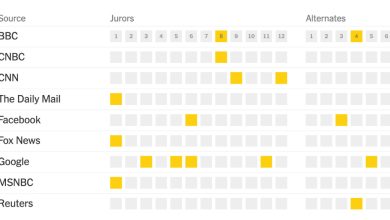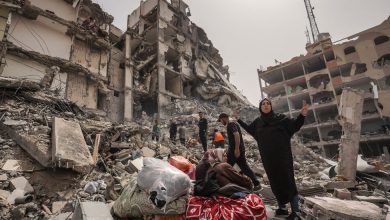Once a Crucial Refuge, ‘Gayborhoods’ Lose L.G.B.T.Q. Residents in Major Cities

SAN FRANCISCO — Cleve Jones has lived in the Castro neighborhood for nearly 50 years, almost from the day he graduated from high school in Phoenix and hitchhiked to California.
He has been a political and cultural leader in San Francisco, organizing gay men and lesbians when the AIDS epidemic devastated these streets in the early 1980s. He created the nationally recognized AIDS Memorial Quilt from a storefront on Market Street. He was a face of the anger and sorrow that swept the Castro in 1978 after the assassination of Harvey Milk, the first openly gay man elected to the Board of Supervisors.
Mr. Jones has helped define the Castro, dancing at its gay bars seven nights a week when he was younger, gathering with friends for drinks and gossip as he grew older. To this day, he is recognized when he walks down its sidewalks. “Hi Cleve — I know who you are,” said Lt. Amy Hurwitz of the San Francisco Police Department, after Mr. Jones began to introduce himself.
But in May, Mr. Jones, 67, left for a small home with a garden and apple and peach trees 75 miles away in Sonoma County after the monthly cost of his one-bedroom apartment soared from $2,400 to $5,200.
His story is not just another tale of a longtime resident priced out of a gentrifying housing market. Across the country, L.G.B.T.Q. neighborhoods in big cities — New York, Houston, Los Angeles, San Francisco among them — are experiencing a confluence of social, cultural and economic factors, accelerated by the Covid-19 pandemic, that is diluting their influence and visibility. In a few cases, some L.G.B.T.Q. leaders say, the neighborhoods’ very existence is threatened.
“I walk around the neighborhood that encouraged me for so many decades, and I see the reminders of Harvey and the Rainbow Honor Walk, celebrating famous queer and trans people,” Mr. Jones said as he led a visitor on a tour of his old neighborhood, pointing out empty storefronts and sidewalks. “I just can’t help but think that soon there will be a time when people walking up and down the street will have no clue what this is all about.”
Housing costs are a big reason for that. But there are other factors as well.
L.G.B.T.Q. couples, particularly younger ones, are starting families and considering more traditional features — public schools, parks and larger homes — in deciding where they want to live. The draw of “gayborhoods” as a refuge for past generations looking to escape discrimination and harassment is less of an imperative today, reflecting the rising acceptance of gay and lesbian people. And dating apps have, for many, replaced the gay bar as a place that leads to a relationship or a sexual encounter.
Many gay and lesbian leaders said this might well be a long-lasting realignment, an unexpected product of the success of a gay rights movement, including the Supreme Court’s recognition of same-sex marriage in 2015, that has pushed for equal rights and integration into mainstream society.
There are few places where this transformation is more on display than in the Castro, long a barometer of the evolution of gay and lesbian life in America. It is a place where same-sex couples crammed the streets, sidewalks, bars and restaurants in defiance and celebration as L.G.B.T.Q. people in other cities lived cloistered lives.
It was the stage for some of the first glimmers of the modern gay rights movement in the late 1960s; the rise to the political establishment with the election of openly gay officials like Mr. Milk; and the community’s powerful response to the AIDS epidemic in the 1980s.
“Gayborhoods are going away,” Mr. Jones said. “People need to pay attention to this. When people are dispersed, when they no longer live in geographic concentrations, when they no longer inhabit specific precincts, we lose a lot. We lose political power. We lose the ability to elect our own and defeat our enemies.”
Cynthia Laird, the news editor of The Bay Area Reporter, an L.G.B.T.Q. newspaper based in San Francisco, said she was reminded of this transformation every time she walked through the neighborhood.
“I wanted to get a picture of people walking in the rainbow crosswalk at the corner of Castro and 18th Street and there was nobody walking,” she said. “The Castro and San Francisco have changed a lot over the past 25 years. We have seen a lot of L.G.B.T.Q. people move from San Francisco to Oakland — which is where I live — and even further out in the East Bay.”
Mr. Jones’s departure has sent tremors through gay neighborhoods across the country, all the more so because it happened in the midst of annual pride celebrations marking the advances of the L.G.B.T.Q. movement since the New York City police raided the Stonewall Inn, a gay bar, in June 1969.
“What I see in Houston is we are losing our history,” said Tammi Wallace, the president of the Greater Houston L.G.B.T. Chamber of Commerce, who lives in Montrose, the city’s gay neighborhood. “A lot of individuals and couples are saying, ‘We can move to different parts of the city and know we are going to be accepted.’”
Daniel B. Hess, a professor of urban planning at the State University of New York at Buffalo, and the co-author of a book about the evolution of gay neighborhoods, said U.S. census data over the past three decades showed a decline in the density of same-sex couples in Chelsea and Greenwich Village in New York City, Dupont Circle in Washington, D.C., West Hollywood in Los Angeles County and the Castro, which he called “America’s premier gay neighborhood.”
“Gay men are moving out of gay neighborhoods,” he said. “They are settling in other urban neighborhoods and close-in suburbs. And non-L.G.B.T.Q. people are moving in and knocking down the concentration in gay neighborhoods.”
Dr. Hess said part of this was generational. The men and women who established these neighborhoods “wanted to segregate and be surrounded by gay people,” he said. “In contrast, when you ask young people today what they want, they would prefer an inclusive coffee shop. They don’t want anyone to feel unwelcome.”
Some gay leaders argued that the instinct to live in communities of like-minded people remained a powerful draw and that there would always be some version of a gayborhood, though perhaps not as concentrated and powerful.
“I say this as a gay man: It’s nice to live in a community where there are a lot of other queer people there, where I can go out and walk on the street to a gay bar,” said Scott Wiener, a California state senator who lives in the Castro. “Where I can walk two blocks to get an H.I.V. and S.T.D. test at a clinic that won’t judge me.”
“We have to be very intentional of protecting these neighborhoods — and keeping them queer,” he said. “With that said, I also believe that the Castro is very strong and has very deep L.G.B.T.Q. roots.”
These changes follow a comparable pattern in American history: Immigrants establish ethnic neighborhoods to escape discrimination and build community ties, but those enclaves lose their distinction and energy as subsequent generations move to suburbs that have become more welcoming
In this case, it is also a story of gentrification, economic cycles and social change. Gay men and women have moved into relatively downtrodden neighborhoods, like the Castro and Montrose, fixing them up. Once housing costs become too high, residents and younger generations have relocated to another downtrodden neighborhood.
In New York City, that has meant a shift from Greenwich Village to Chelsea to Hell’s Kitchen; in the Los Angeles area, a migration from West Hollywood to neighborhoods like Silver Lake. But the relocations this time have been more far-flung.
“I know a lot of new gay dads who are living in Fort Greene and Clinton Hill,” two neighborhoods in Brooklyn, said Corey Johnson, a former speaker of the New York City Council who is gay and lives in Greenwich Village. “They are not traditional gay neighborhoods. Schools are better. It’s more affordable. And you have more space.”
Mr. Johnson argued this had in fact resulted in an increase of openly gay and lesbian members of the City Council. But other L.G.B.T.Q. leaders said there was a real danger in this kind of diaspora.
“I think it’s important that we have spaces where we walk around, hold hands and maybe share a brief kiss and not be too worried,” said Tina Aguirre, the manager of the Castro L.G.B.T.Q. Cultural District. “We need to live in queer neighborhoods. It’s just not as pressing as it was in the ’80s and ’90s.”
On a beautiful afternoon in June, gay rainbow flags were fluttering up and down Castro Street as Mr. Jones walked by reminders of an earlier era. The Castro Theater, a landmark backdrop for parades and protests over decades, is reopening after a long closure forced by Covid-19. Men, mostly, were drinking in bars, and some of the sex shops were open. At one point, a completely naked man walked nonchalantly past on the sidewalk.
“I guess he’s trying to keep the neighborhood gay, too,” Mr. Jones said.
Mr. Jones paused by the storefront where Mr. Milk had a camera shop. In 1979, Mr. Jones lived two houses away and watched from his apartment when the police moved in on protesters on Castro Street following the lenient verdicts handed down to Dan White, a former supervisor, for the assassinations of Mr. Milk and George Moscone, the San Francisco mayor. “The night of the White Night riots, when the police counterattacked, we were out on the fire escape up there just watching the chaos,” Mr. Jones said.
Mr. Milk, evicted from his Castro Street storefront, had later moved his camera shop over Market Street. That was the space Mr. Jones used for the AIDS quilt project. It is today a restaurant.
Mr. Jones is not happy about leaving this corner of San Francisco, but said he had little choice. He had lived in his Castro apartment for 11 years before his landlord asserted that he forfeited his rent control protections by living in Sonoma County, effectively forcing him out by more than doubling his rent. He said he liked having the getaway of his home in Guerneville, but had considered himself a city person from the day he arrived here as a teenager from Phoenix.
“Everything good in my life has come out of this neighborhood,” he said.




